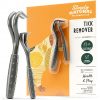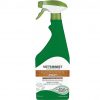You know the feeling. You’re giving your dog a nice scratch behind the ears, when suddenly that tell-tale bump pops up under your fingers. The dreaded tick! Ticks tend to attach themselves around the soft skin of the head, neck and ears, but you can find them anywhere on the dog’s body. Ticks are more prevalent in warmer months and in certain geographical areas, such as heathland and forests. Because ticks carry diseases, it’s vital you know how to remove a tick from a dog, so that you can get the blood-sucking creepy crawly out of your dog’s skin as quickly as possible. The simplest way is to use a tick hook.
Removing a tick from a dog is not quite as simple as plucking a piece of fruit. Unlike a mosquito, for example, ticks don’t just stick a point in when they bite, and leave their victim be. They attach themselves very firmly so they can stay there sucking blood from their host for days on end. They do this with curved teeth and spines on their mouth parts, which they bury deep inside the skin as well as a feeding tube, which makes the tick very difficult to remove.
It’s important not to squeeze the tick’s swollen body, which can cause it to regurgitate its own fluids (saliva and gut contents) back into your dog’s bloodstream, which will increase the risk of infection. Nor do you want to leave the head and the mouthparts inside the dog’s skin by just pulling off the tick’s body. Once you have removed the tick, monitor the site of the bite, and if you notice any redness or swelling, or if your dog isn’t his usual self, contact your vet.
If you use a regular parasite treatment, it should cover ticks, which means that any ticks that attach themselves to your dog will die and fall off within a day or two. Consult your vet if you live in an area with high tick prevalence. There are also tick repellents, which you can apply before going out for walks. Or you can use a tick-repellent collar, which lasts for several months and usually guards against fleas as well.
How to remove a tick from a dog
- You will need some sort of tool. The ideal is a tick-remover tool, or fine-pointed tweezers with curved points, which are slender enough to get really close to the tick’s mouth, without touching its body. Fingers are nowhere near precise enough and are likely to cause compression on the tick’s body, or leave mouthparts under the dog’s skin.
- Part the fur, so that the tick is clearly showing. If using a tick-remover tool, slide it gently under the tick’s body, as close to the mouthparts as possible and twist in either direction (it doesn’t matter which, but don’t change direction mid-tick). The twisting action apparently helps to crack the saliva cement that ticks use to attach themselves. It should detach after three rotations.
- Do not twist if you are using tweezers. Instead, grasp the tick as close to the skin as possible and gently pull upwards, without jerking or twisting.
- Do not handle the tick with bare hands, in case of infection.
- Wrap the tick in a piece of tissue and squash it with your shoe on the ground. Then dispose of it, still in the tissue either down the toilet or in the dustbin.
- Apply antiseptic to the wound, and clean your tweezers.
There are old wives’ tips that don’t work – some people try to suffocate the tick by smothering it with nail polish, petroleum jelly, toothpaste or alcohol. But it rarely has the desired effect of killing it quickly, and can cause the tick to expel the contents of the gut into your dog’s bloodstream, thereby increasing the risk of infection.
You may also enjoy reading…

Buzz off: the best flea treatments for dogs

Sleek and shiny: best dog conditioners to detangle coats and soothe itchy skin

Nail it! The best clippers to keep your dog’s claws in perfect shape

Music to your ears: the best aural cleaners for dogs

Best dog grooming brushes for luscious locks and shiny coats

Subscribe to Horse & Hound magazine today – and enjoy unlimited website access all year round
Horse & Hound magazine, out every Thursday, is packed with all the latest news and reports, as well as interviews, specials, nostalgia, vet and training advice. Find how you can enjoy the magazine delivered to your door every week, plus options to upgrade your subscription to access our online service that brings you breaking news and reports as well as other benefits.







